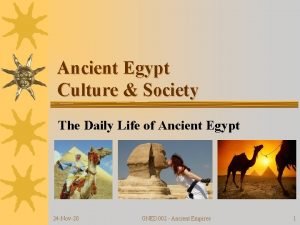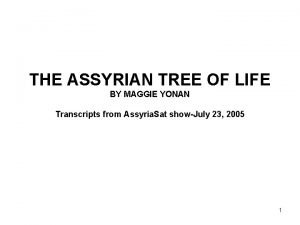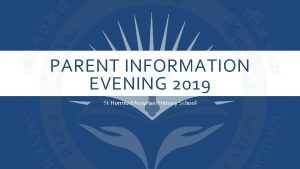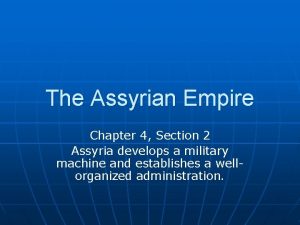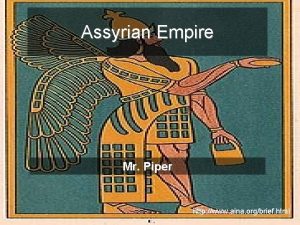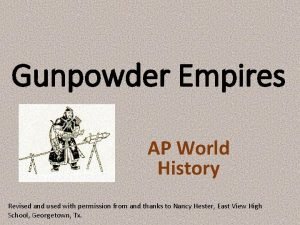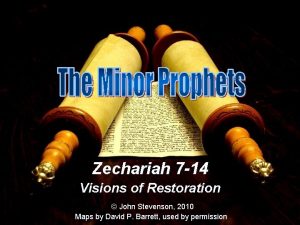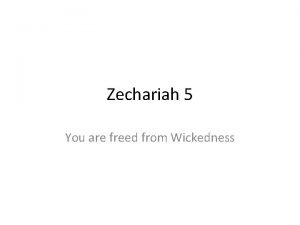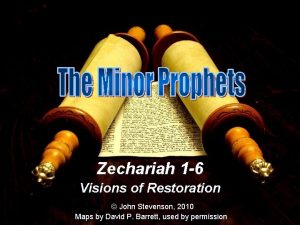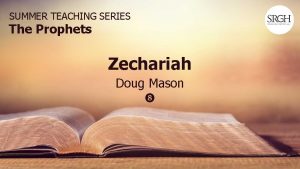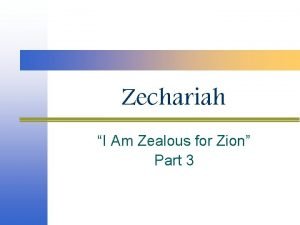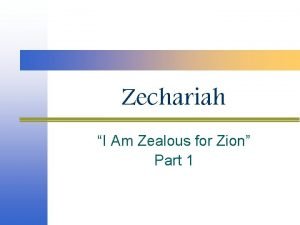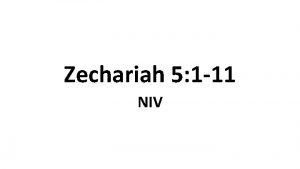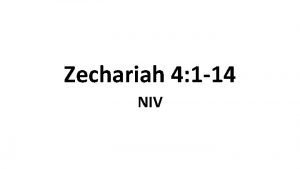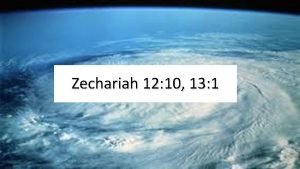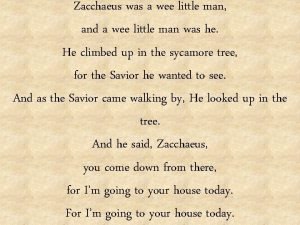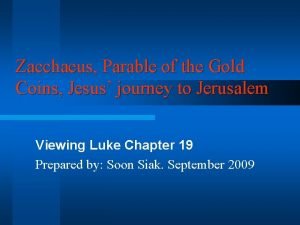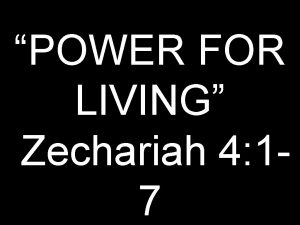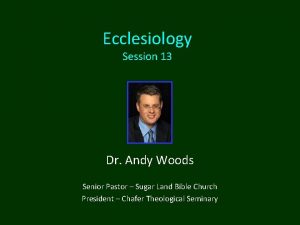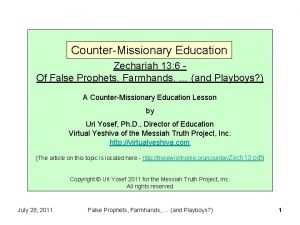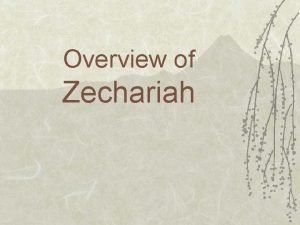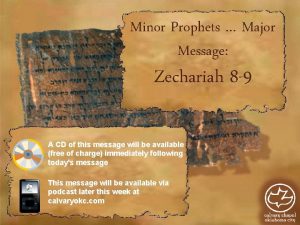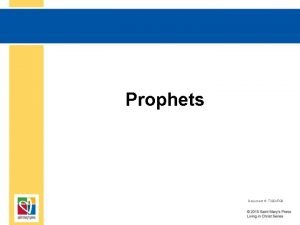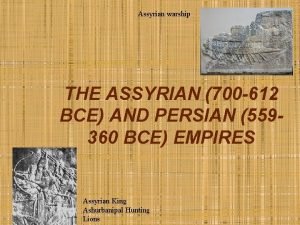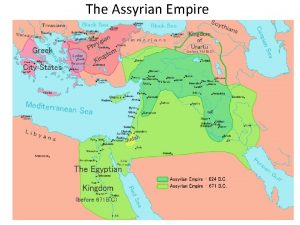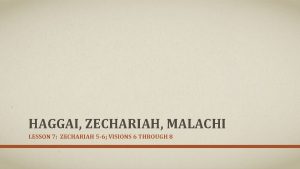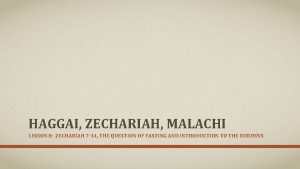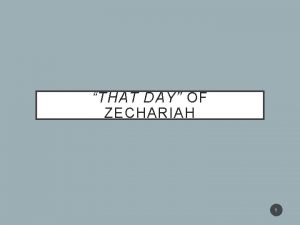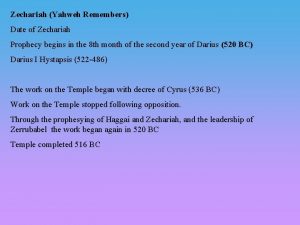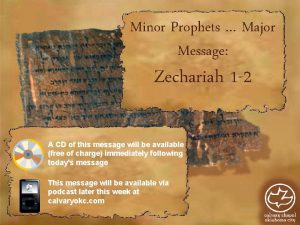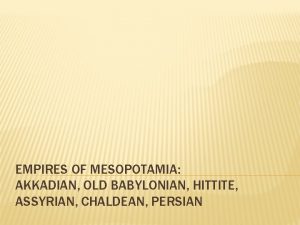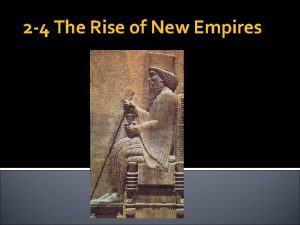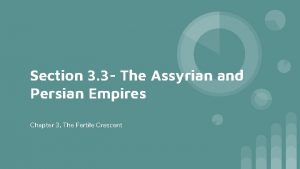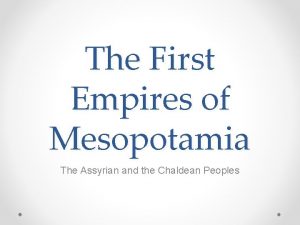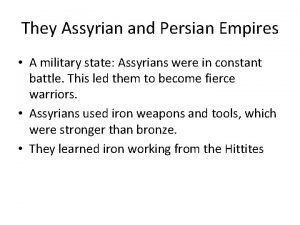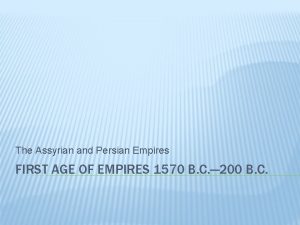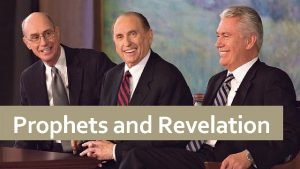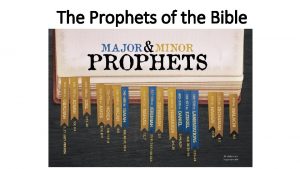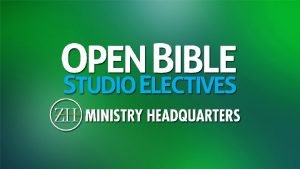Zechariah Ancient World Empires Prophets of the Assyrian






























- Slides: 30

Zechariah

Ancient World Empires • Prophets of the Assyrian Period Jonah Joel Amos Hosea Isaia h Micah Zephaniah Nahum • Prophets of the Babylonian Period Jeremiah Habakkuk Ezekiel O badiah Daniel • Prophets of the Persian Period Haggai Zechariah Malachi



A Contemporary of Haggai


Ezra 5: 1 -2 NASB When the prophets, Haggai the prophet and Zechariah the son of Iddo, prophesied to the Jews who were in Judah and Jerusalem in the name of the God of Israel, who was over them, (2) then Zerubbabel the son of Shealtiel and Jeshua the son of Jozadak arose and began to rebuild the house of God which is in Jerusalem; and the prophets of God were with them supporting them. Ezra 6: 14 NASB And the elders of the Jews were successful in building through the prophesying of Haggai the prophet and Zechariah the son of Iddo. And they finished building according to the command of the God of Israel and the decree of Cyrus, Darius, and Artaxerxes king of Persia.


Emphases: • God is with those who have returned from exile. • Jerusalem and Judah have a bright and glorious future. • A king of Israel will come. He will be victorious, but will be killed for the sins of the people. • The enemies of God’s people will be punished. • The nations will come to know God.

Structure: Basic Division • Two general divisions (Chs. 1 -8 and 9 -14). • Chapters 1 though 8 regard the near future while chapters 9 -14 the distant future.

Structure: Chapters 1 -8 • Call to repentance (1: 2– 6) • Eight interpreted visions (1: 7– 6: 15). • Fasting and future blessings (78).

Structure: Chapters 9 -14 • 9 -14 contain(chs. 9– 11 and 12– 14) having to do with God’s glorious future for his people and judgment on his/their enemies. • Oracle 1: 9 -11 – God’s judgment against surrounding nations (9. 1 -8) in the context of. . . – Rejection of the Messiah/King (9. 9 -17; 11. 4 -17) and gathering of God’s people (10. 1 -11. 3). • Oracle 2: 12 -14 – Continues with the prior themes, but sets them in context of the coming “day” of Christ. – Chapter 14 ends with the final defeat of enemies of God and the establishment of the kingdom through which all nations will worship Him.

Advice for Zechariah • A difficult read because of its symbolic nature (visions and whatnot). It is also difficult to determine who is speaking or being referred to at different point (pronoun-antecedent problem). • Understanding the historical context and the two focii, the rebuilding of the temple and the coming King/age (Christ/Christian Age), will help.

The Night Visions • “They are arranged in a concentric (chiastic) pattern. ” – “Visions 1 and 8 (1: 7– 17; 6: 1– 8) both envision four groups of colored horses, whose purpose is to go throughout the whole earth, as the backdrop for the building of the temple. ” – “Visions 2 and 3 (1: 18– 21; 2: 1– 13) and 6 and 7 (5: 1– 4; 5: 5– 11) have to do with obstacles facing the restoration community and its building of the temple (in 2 and 3 the obstacles come from without and in 6 and 7 from within). ” – “Visions 4 and 5 (3: 1– 10; 4: 1– 14) are the centerpiece, dealing especially with Joshua’s and Zerubbabel’s leadership, both for the building of the temple and for leading the community. ” • Fee, G. D. , & Stuart, D. K. (2002). How to read the Bible book by book: a guided tour (pp. 257 – 258). Grand Rapids, MI: Zondervan.

The Night Visions • There is a pattern of Zechariah describing what he sees, making inquiry about its meaning, and the angel interpreting or explaining it. • “Four of the visions ([1] 1: 14– 17; [3] 2: 6– 13; [5] 4: 6– 10 a; [8] 6: 9– 15) also contain one or more oracles, which make specific the message of the visions. ” • “The heart of all of this is a word of encouragement, declaring to the people that the time is ripe—the conditions are now in place for them to rebuild—while at the same time it is, as with Haggai, a word of encouragement to those in leadership. ” • Fee, G. D. , & Stuart, D. K. (2002). How to read the Bible book by book: a guided tour (p. 258). Grand Rapids, MI: Zondervan.

Chapters 9 -14 • “The two oracles in chapters 9– 14 are especially difficult to follow, but in the main they follow a pattern as well. Both have to do with the triumphal intervention of the Lord in the affairs of Judah and the nations. The first looks toward the more immediate future, the second toward the final coming of God’s universal rule. Common to both is the central place of God’s kingly Messiah, and the fact that he is rejected by the people. ” • Fee, G. D. , & Stuart, D. K. (2002). How to read the Bible book by book: a guided tour (p. 258). Grand Rapids, MI: Zondervan.

A WALK THROUGH ZECHARIAH

1: 1– 6 Introduction • Both the heading, which dates about two months after Haggai’s initial word, and the words that follow serve as a validation of the prophet: This is what God has told Zechariah to tell the people, which affirms that the covenant is still in effect and calls for their obedience (in contrast to the way their ancestors behaved).

Vision 1: The Horsemen: God’s Return to Jerusalem • 1: 7– 17 • Note the parts as you read: (1) the vision itself (v. 8); (2) Zechariah’s question about meaning (vv. 9– 10); (3) the interpreting angel’s response: They are the patrol who has gone throughout the whole earth and find it at rest; (4) the oracle(s)—Yahweh is returning to Jerusalem, so the people must not rest but must rebuild the temple.

Vision 2: Four Horns Destroyed • 1: 18– 21 • Note how this vision is in two parts with explanations. The days of the nations responsible for the exile (of both Judah and Israel) are over.

Vision 3: Jerusalem Cannot Be Measured—The Return of Prosperity • 2: 1– 13 • Note how the explanation (vv. 4– 13) takes the form of a series of oracles—the coming greatness of Jerusalem with Yahweh as her protector (vv. 4 – 5); a call to the exiles in Babylon to return (vv. 6 – 9; thus picking up from vision 2); Yahweh’s dwelling in Zion as universal sovereign (vv. 10– 13; thus filling out the present vision). Note also how verse 13 echoes Habakkuk 2: 20.

Vision 4: The Reinstatement of the High Priest • 3: 1– 10 • Remember that this is the first of the two central visions. Since at stake is the rebuilding of the temple, the place of God’s presence, this vision has to do with cleansing the high priest, who is to function in the temple once it is rebuilt. Note the progression from clean garments and turban (vv. 3– 5) to recommissioning (vv. 6– 7) to the promised Branch (v. 8, referring ultimately to the coming Davidic king; cf. Isa 11: 1; 53: 2; Jer 23: 5); the vision concludes by anticipating the oracle in Zechariah 8: 1– 8.

Vision 5: The Lampstand the Olive Trees—God’s Renewing Spirit/Presence • 4: 1– 14 • Note the slightly different structure: the vision (vv. 1– 3), now with two sets of questions (vv. 4– 5, 11– 13) and explanations (vv. 6– 10, 14)— to encourage Zerubbabel that God’s Spirit will bring about what human power cannot—plus an affirmation of his and Joshua’s leadership.

Vision 6: The Flying Scroll—Banishment of Evil from Judah • 5: 1– 4 • Now you are back to a brief vision and explanation: The evil that persists in Judah will be banished from the land.

Vision 7: The Woman in a Basket—Wickedness Exiled to Babylon • 5: 5– 11 • Watch for the irony in this vision, as well as its relationship to previous visions: The people will return from exile (vision 3), Babylon has been overthrown (vision 2), the temple will be rebuilt (visions 4– 5); so what happens to wickedness? It will be exiled to Babylon!

Vision 8: The Four Chariots—God at Rest and a Crown for Joshua • 6: 1– 15 • Note how this vision wraps up the series. This new patrol of four horsemen again goes throughout the earth and finds it at rest (especially Babylon, the “north country, ” v. 6)— all of this to say that the time for rebuilding is now. • The “word” that came to Zechariah that concludes the visions (vv. 9– 15) both supplements and reinforces the concerns that have preceded (Joshua, the Branch, the rebuilding of the temple).

In Response to a Question about Fasting • • • 7: 1– 8: 23 A question related to special fasts in connection with the fall of Jerusalem becomes the catalyst for a series of oracles that take a concentric (chiastic) pattern similar to the visions. 7: 1– 3 The question: Do we continue to mourn and fast over Jerusalem’s fall? 7: 4– 14 A judgment against fasting without obedience to the covenant 8: 1– 8 A picture of restored Jerusalem, which serves to inspire 8: 9– 13 An encouragement to rebuild the temple 8: 14– 17 True fasting expresses itself in showing mercy and justice (cf. Isa 58) 8: 18– 19 The question answered: Let the fasts be turned into joyful celebrations Note how the two appended oracles (8: 20– 23) anticipate the fulfillment of the Abrahamic covenant that includes the Gentiles (Gen 12: 3). And finally note how the two sections of the book end on this same note (Zech 8: 20– 23; 14: 16– 19).

Zion’s King and the Glorious Future for God’s People • 9: 1– 11: 17 • This first oracle resorts to the poetic pattern of the earlier prophets. • Look for the following progression: What begins with a judgment on the surrounding nations (9: 1– 8) turns into the promised restoration of the Davidic king (vv. 9– 17) and of a united Israel (10: 1, 3 b– 12). • Note that the latter is enclosed by a denunciation of false shepherds (10: 2– 3 a; 11: 1– 6, 14– 17) and that the last of these encloses a picture of God’s true shepherd who will be rejected by the people (11: 7– 13), which in turn anticipates the central section of the next oracle (12: 10– 13: 9).

The Smiting and Final Triumph of God’s King • 12: 1– 14: 2 • Note how this second oracle picks up themes from the first one, especially the rejection of the true shepherd, while setting the whole in a more totally eschatological setting regarding the day of Yahweh (“that day”). • This in turn is placed in the setting of the final eschatological expression of the holy war, where the enemy surrounds and ransacks Jerusalem (12: 1– 3 a; 14: 1– 2) and the King is killed (12: 10– 13: 7)—but in the end God’s glorious final kingdom emerges (12: 3 b– 9; 14: 3– 21).

Conclusion • “The book of Zechariah advances the biblical story by reminding us that God’s presence by his Spirit is at the heart of a restored Israel, while at the same time anticipating the sacrificial death of the Messiah who is to come. ” • Fee, G. D. , & Stuart, D. K. (2002). How to read the Bible book by book: a guided tour (p. 261). Grand Rapids, MI: Zondervan.
 Land based vs maritime empires
Land based vs maritime empires Early empires in the ancient near east
Early empires in the ancient near east Ancient empires jar
Ancient empires jar Assyrian tree of life
Assyrian tree of life Parent
Parent Assyrian archers pursuing enemies
Assyrian archers pursuing enemies The assyrian empire chapter 4 section 2
The assyrian empire chapter 4 section 2 Ashurism
Ashurism Neo assyrian empire
Neo assyrian empire Tamerlame
Tamerlame Gunpowder ap world history
Gunpowder ap world history Zechariah 1:14
Zechariah 1:14 Zechariah stevenson
Zechariah stevenson Zechariah 5:8
Zechariah 5:8 Zechariah stevenson
Zechariah stevenson Mason moore jealous
Mason moore jealous Zechariah stevenson
Zechariah stevenson Zechariah stevenson
Zechariah stevenson Flying scroll
Flying scroll Zechariah 14 niv
Zechariah 14 niv Zechariah stevenson murder
Zechariah stevenson murder Zacchaeus was a wee little man words
Zacchaeus was a wee little man words Parable of gold coins
Parable of gold coins Zachariah 4:6
Zachariah 4:6 Andy woods zechariah
Andy woods zechariah Zechariah 13:6
Zechariah 13:6 Zechariah timeline
Zechariah timeline Zechariah 8 message bible
Zechariah 8 message bible Ancient and modern means of communication
Ancient and modern means of communication Ancient india vs ancient china
Ancient india vs ancient china Non writing prophets
Non writing prophets


